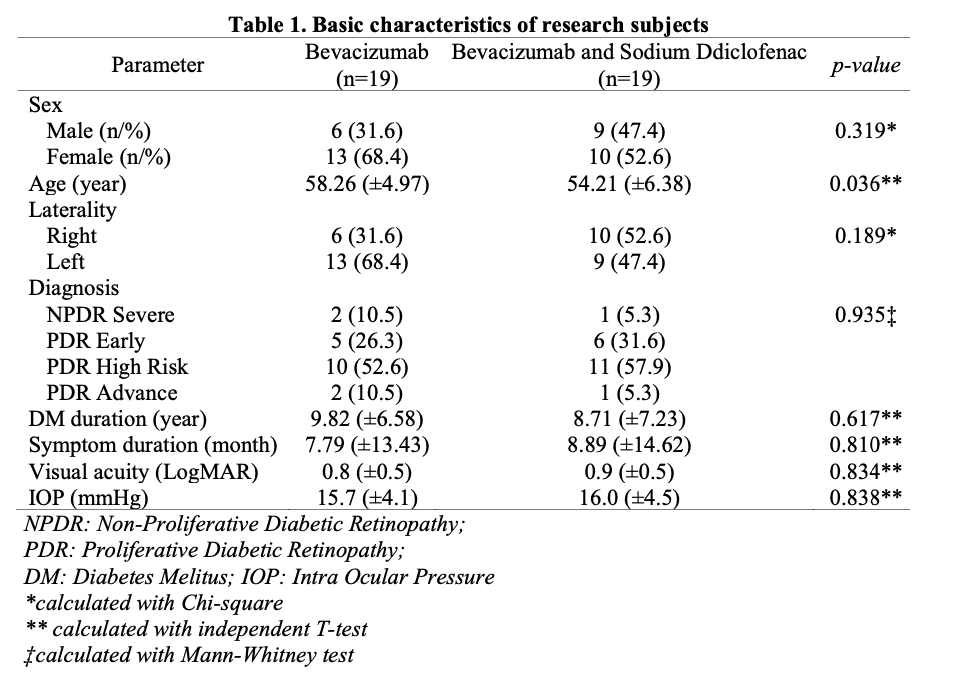Bevacizumab vs Ranibizumab in Macular Edema due to Retinal Vein Occlusion: Short-term Outcomes
Abstract
Introduction & Objectives
Bevacizumab or Ranibizumab was widely used as therapy for macular edema (ME) in retinal vein
occlusion (RVO) and diabetic retinopathy. The purpose of this study was to comparing short-term
outcomes for patients who received intravitreal Bevacizumab (IVB) injection or Ranibizumab (IVR)
for ME due to RVO
Methods
This was observational, cross sectional study comparing patients received IVB or IVR. Primary
outcomes data (visual acuity and central macular thickness/CMT) and secondary outcomes data
(number injection and intra ocular pressure/IOP) were collected at baseline and 3 months after
injection
Results
There were 4 eyes in each group. There were no significant difference in mean change of visual
acuity (-0.275±0.25 vs -0.15±0.5 logMAR; p=0.676) and CMT (-171.50±129.08 vs -98.25±37.67 um;
p=0.345) in IVB vs IVR groups. There were also no significant difference in mean change of IOP
(2±2.16 vs 2±4.69 mmHg; p=1) and number of injection (2.25±0.50 vs 1.75±0.9; p=0.401 ) in both
groups.
Conclusion
In short-term both IVB and IVB have relative similar outcomes on increasing visual acuity and
decreasing CMT in ME due to RVO
Full text article
References
Klein R, Moss SE, Meuer SM, Klein BE. The 15-year cumulative incidence of retinal vein occlusion. The Beaver Dam eye study. Arch Ophthalmol. 2008;126:513–518.
Brand CS. Management of retinal vascular diseases: a patient-centric approach. Eye. 2012;26(S2):S1–S16
Qian T, Zhao M, Wan Y, et al. Comparison of the efficacy and safety of drug therapies for macular edema secondary to central central retinal vein occlusion. BMJ Open. 2018;8e022700
The Royal College of Ophthalmologists. Retinal vein occlusion (RVO) guidelines. 2015
Rehak J, Rehak M. Branch retinal vein occlusion: pathogenesis, visual prognosis, and treatment modalities. Curr Eye Res 2008;33:111-31.
Ranibizumab for macular edema due to retinal vein occlusions: implication of VEGF as a critical stimulator. Mol Ther 2008;16:7919.
Bakri SJ, Snyder MR, Reid JM, et al. Pharmacokinetics of intravitreal ranibizumab (Lucentis). Ophthalmology 2007; 114:2179-82. 18.
Bakri SJ, Snyder MR, Reid JM, et al. Pharmacokinetics of intravitreal bevacizumab (Avastin). Ophthalmology 2007; 114:855-9.
Yilmaz T, Cordero-Coma M. Use of bevacizumab for macular edema secondary to branch retinal vein occlusion: a systematic review. Graefes Arch Clin Exp Ophthalmol 2012;250:787-93.
Ehlers JP, Decroos FC, Fekrat S. Intravitreal bevacizumab for macular edema secondary to branch retinal vein occlusion. Retina 2011;31:1856-62.
Kim M, Yu SY, Kim ES, et al. Intravitreal ranibizumab for macular edema secondary to retinal vein occlusion. Ophthalmologica 2012;227:132-8.
Noma H, Yasuda K, Shimura M. Cytokines and Pathogenesis of Central Retinal Vein Occlusion. JClinMed. 2020;9:3457
Son BK, Kwak HW, Kim ES, et al. Comparison of ranobizumab and bevacizumab for macular edema associated with branch retinal vein occlusion. Korean J Ophthalmol. 2017;31(3):209-16
Hykin P, Prevost AT, Vasconcelos JC, et al. Clinical effectiveness of intravitreal therapy with ranibizumab vs aflibercept vs bevacizumab for macular edema secondary to central retinal vein occlusion: A randomized clinical trial. Jama Ophthalmol.2019;137(11):1256-64
Sangroongruangsri S, Ratanakorn T, Wu O, et al. Comparative efficacy of bevacizumab, ranibizumab, and aflibercept for treatment of macular edema secondary to retinal vein occlusion: a systematic review and network meta-analysis. Expert review of clinical pharmacology. 2018;11(9):903-16.
Roger S, McIntosh RL, Cheungetal N, et al. The prevalence of retinal vein occlusion: pooled data from population studies from the United States, Europe, Asia, and Australia. Ophthalmology. 2010;117(2):.313–9.
Zhou JQ, Xu L, Wang S, et al. The 10-year incidence and risk factors of retinal vein occlusion: the Beijing eye study. Ophthalmology. 2013;120(4):803–8.
Kolar P. Risk factors for central and branch retinal vein occlusion: a meta-analysis of published clinical data. Journal of Ophthalmology. 2014:1-5
Yau JWY, Lee P, Wong TY, et al. Retinal vein occlusion: an approach to diagnosis, systemic risk factors and management. Internal Medicine Journal. 2008;38(12):904–10
Vader M, Schauwvlieghe A, Verbraak F, et al. Comparing the Efficacy of Bevacizumab and Ranibizumab in Patients with Retinal Vein Occlusion: BRVO study, a Randomized Trial. Ophthalmology Retina 2020;4:576-87
Rajagopal R, Shah GK, Blinder KJ, et al. Bevacizumab versus ranibizumab in the treatment of macular edema due to retinal vein occlusion: 6-month results of the CRAVE Study. Ophthalmic Surg Lasers Imaging Retina. 2015;46: 844-50.
Narayanan R, Panchal B, Das T, et al. A randomised, doublemasked, controlled study of the efficacy and safety of Footnotes and Financial Disclosures intravitreal bevacizumab versus ranibizumab in the treatment of macular oedema due to branch retinal vein occlusion: MARVEL report no. 1. Br J Ophthalmol. 2015;99:954-9.
Hollands H, Wong J. Bruen R, et al. Short-term intracocular pressure changes after intravitreal injection of bevacizumab. Can J Ophthalmol. 2007;42(6):807-11
Lee JW, Park H, Choi JH, et al. Short-term changes of intraocular pressure and ocular perfusion pressure after intravitreal injection of bevacizumab or ranibizumab. BMC Ophthalmology. 2016;16:69
Mansoori T, Agraharam SG, Manwani S, et al. Intraocular pressure changes after inravitreal bevacizumab or ranibizumab injection: a retrospective study. J Curr Ophthalmol. 2021;33:6-11
Brown DM, Campochiaro PA, Bhisitkul RB, et al. Sustained benefits from ranibizumab for macular edema following branch retinal vein occlusion: 12month outcomes of a phase III study. Ophthalmology. 2011; 118(8):1594–1602.
Campochiaro PA, Heier JS, Feiner L, et al. Ranibizumab for macular edema following branch retinal vein occlusion: six-month primary end point results of a phase III study. Ophthalmology. 2010;117(6): 1102–1112.e1.
Campochiaro PA, Brown DM, Awh CC, et al. Sustained benefits from ranibizumab for macular edema following central retinal vein occlusion: twelvemonth outcomes of a phase III study. Ophthalmology. 2011; 118(10):2041–2049.
Jumper JM, Dugel Pu, Chen S, et al. Anti-vegf treatment of macular edema associated with retinal vein occlusion: patterns of use and effectiveness in clinical practice (ECHO study report 2). Clin Ophthalmol. 2018; 12:621-9.
Authors
Copyright (c) 2023 CHALID KURNIAWAN

This work is licensed under a Creative Commons Attribution-NonCommercial-ShareAlike 4.0 International License.


